
Ncert Solutions for class 10 subject Maths Chapter 2 POLYNOMIALSin pdf Best Free NCERT Solutions for class 1 to 12 in pdf NCERT Solutions, cbse board, Maths, ncert Solutions for Class 10 Maths, class 10 Maths ncert solutions, POLYNOMIALS, Class 10, ncert solutions chapter 2 POLYNOMIALS, class 10 Maths, class 10 Maths ncert solutions, Maths ncert solutions class 10, Ncert Solutions Class 10 Mathematics Chapter 2 POLYNOMIALS
If p(x) is a polynomial in terms of x, the highest power of x in p(x) is called the degree of the polynomial p(x).
For example:
3x + 2 is a polynomial of x. Degree of expression is 1
4z^2 –z + 2 is a polynomial of z. Degree of expression is 2,
3x^3 – 2x – 2 is a polynomial of x. Degree of expression is 3
< style="color:#FF0000">
Type of polynomials
Linear polynomial :-A polynomial of degree 1 is called a linear polynomial.
For example: 7x + 43Quadratic polynomial :-
A polynomial of degree 2 is called a quadratic polynomial.
For example: x^2 + 3x + 7 Cubic polynomial :-A polynomial of degree 3 is called a cubic polynomial
For example: x^3 + 3x Zeros of the polynomial :-A real number t is called a zero of a polynomial if the value of f(t) = 0
For example
f(x) = x^2 – 6x +8
zeros of this equation are 2 and 4 because
f(2)= 2^2 -6*2 + 8 = 0
f(4)= 4^2 – 6*4 + 8 =0
Sum and product of root of quadratic equation :-
For a equation ax^2 + bx + c = 0 , if root are α and β ,
.jpg)
Roots for cubic equation :-
For a equation ax^3 + bx^2 + cx + d = 0
.jpg)
If p(x) and g(x) are any two polynomials with g(x) is not equal to 0, then we can find polynomials q(x) and r(x) such that
If r(x) = 0 or degree of r(x) < degree of g(x).
Dividend = Divisor × Quotient + Remainder
p(x) = g(x) × q(x) + r(x),
Question 1. The graphs of y = p(x) are given in Fig. 2.10 below, for some polynomials p(x). Find the number of zeroes of p(x), in each case.
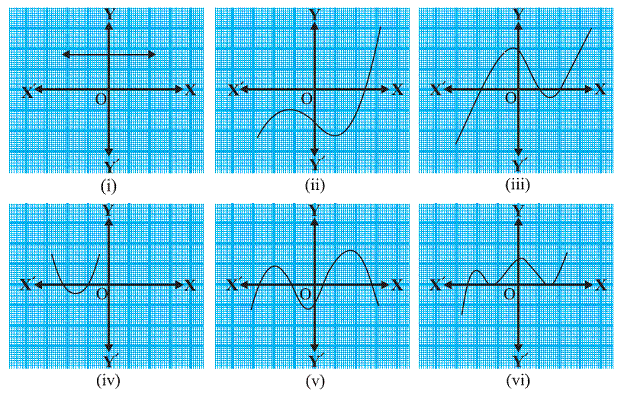
Answer
(i)the graph does not intersect the x axis so that there are no zero in this graph
(ii)the graph intersects the x axis at one places so that here are one zeros in this graph
(iii)the graph intersects the x axis at three places so that there are three zeros in this graph
(iv)the graph intersects the x axis at two places so there are two zeros in this graph
(v) the graph intersect the x axis at four places so there are four zeros in this graph
(vi) the graph intersects the x axis at three places so that there are three zeros in this graph
1. Find the zeroes of the following quadratic polynomials and verify the relationship between the zeroes and the coefficients.
(iii) 4u² + 8u
(iv) 4u² + 8u
Factorize the equation
Compare the equation with au² + bu + c = 0
We get
a = 4 ,b=-8 c= 0
To factorize the value we can take 4u common there
4u(u+2) = 0
First zero
4u = 0
U = 0
second zero
u+2 = 0
u = - 2
sum of zero 0 - 2 = - 2
product of zero 0 x ( - 2 ) = 0
Sum of zero -b/a = -(8/4) = -2
Product of zero c/a = 0/4 = 0
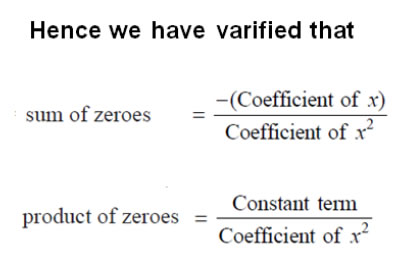
1. Find the zeroes of the following quadratic polynomials and verify the relationship between the zeroes and the coefficients.
(vi)3x² – x – 4
(vi) 3x² – x – 4
Factorize the equation
3x² – x – 4
Compare the equation with ax² + bx + c = 0
We get
a = 3 ,b=-1 c= -4
to factorize the value we have to find two value which
sum is equal to b =-1
product is a*c = 3*-4 = -12
3 and -4 are such number which
Sum is 3 – 4 = - 1
Product is 3 *- 4 = - 12
So we can write middle term -x = 3x – 4x
We get
3x² + 3x - 4x - 4 = 0
3x(x +1) -4(x + 1) = 0
(x + 1) (3x - 4) = 0
x + 1 = 0 , 3x - 4 = 0
Solve for first zero
x = - 1
solve for second zero
3x-4 = 0
3x = 4
x = 4/3
Sum of zeros -b/a = -(-1/3) = 1/3
Product of zero c/a = -4/3 = 4/3

1. Find the zeroes of the following quadratic polynomials and verify the relationship between the zeroes and the coefficients.
(v) t² – 15
(v) t² – 15
Factorize the equation
t² – 15 = 0
Add 15 both side we get
t² = 15
Take square root both side
t= ± √15
First zero is √15
second zerois - √15
Sum of zero √15 - √15 = 0
Product of zero √15 x -√15 = -15
Compare the equation with at² + bt +c = 0
We get
a = 1, b = 0, c = -15
Sum of zero -b/a = -(0/1) = 0
Product of zero c/a = -15/1 = -15

1. Find the zeroes of the following quadratic polynomials and verify the relationship between the zeroes and the coefficients.
(iii) 6x² – 3 – 7x
(iii) 6x² – 3 – 7x
Factorize the equation
6x² – 7x – 3
Compare the equation with ax² + bx + c = 0
We get
a = 6 ,b=-7 c= -3
To factorize the value we have to find two value which
sum is equal to b =-7
product is a x c = 6 x -3 = -18
2 and -9 are such number which
sum is 2 – 9 = - 7
product is 2 x - 9 = - 18
So we can write middle term -7x = 2x – 9x
We get
Plug the values of a , b and c we get
Sum of zeros -b/a = -(-7/6) = 7/6
Product of zero c/a = -3/6 = -1/2

1. Find the zeroes of the following quadratic polynomials and verify the relationship between the zeroes and the coefficients.
(i) x² – 2x – 8
(i)
Factorize the equation
![]()
2 and -4 are such number which
So we can write middle term -2 x = 2 x – 4 x
We get
x²+2x-4x-8=0
x (x + 2)-4(x + 2) = 0
(x+2) (x-4) = 0
First zero
x + 2 = 0
x = -2
Second zero
x-4 = 0
x = 4
sum of zero -2 + 4 = 2
product of zero 2 x -4 = -8
For a equation ax² + bx + c = 0 , if zeroare α and β ,
Plug the values of a , b and c we get
Sum of zeros -b/a = -(-2/1) = 2
Product of zeros c/a =-8/1 = -8

1. Find the zeroes of the following quadratic polynomials and verify the relationship between the zeroes and the coefficients.
(ii) 4s² – 4s + 1
Factorize the equation
Compare the equation with as² + bs + c = 0
We get
a = 4 , b = -4, c = 1
To factorize the value we have to find two value which
sum is equal to b = -4
product is a x c = 4
-2 and -2 are such number which
sum is (– 2)+( – 2) = - 4
product is (- 2 )* (- 2) = 4
So we can write middle term - 4s = -2s – 2s
We get
4s² - 2s - 2s + 1 = 0
2s(2s -1) -1(2s -1) = 0
(2s - 1) (2s - 1) = 0
2s - 1 =0
2s = 1
s = ½
2s - 1 =0
2s = 1
S = ½
Sum of zero = -b/a = -(-4/4) = 1
Product of zero= c/a = 1/4 = 1/4

Question 2. Find a quadratic polynomial each with the given numbers as the sum and product of its zeroes respectively.
(i)1/4 , -1 (ii) √2 , 1/3 (iii) 0, √5 (iv) 1,1 (v) -1/4 ,1/4 (vi) 4,1
(i)1/4, -1
Now formula of quadratic equation is
x²-(Sum of root)x + (Product of root) = 0
Plug the value in formula we get
x² –(1/4)x -1 = 0
Multiply by 4 to remove denominator we get
4x² - x -4 = 0
(ii) √2 , 1/3
Now formula of quadratic equation is
x²-(Sum of root)x + (Product of root) = 0
Plug the value in formula we get
x² –(√2)x + 1/3 = 0
Multiply by 3 to remove denominator we get
3x² - 3√2 x + 1 = 0
(iii) 0, √5
Now formula of quadratic equation is
x²-(Sum of root)x + (Product of root) = 0
Plug the value in formula we get
x² –(0)x + √5 = 0
simplify it we get
x² + √5 = 0
(iv) 1,1
Now formula of quadratic equation is
x²-(Sum of root)x + (Product of root) = 0
Plug the value in formula we get
x² –(1)x + 1 = 0
simplify it we get
x² - x + 1 = 0
(v) -1/4 ,1/4
Now formula of quadratic equation is
x²-(Sum of root)x + (Product of root) = 0
Plug the value in formula we get
x² –(-1/4)x + 1/4 = 0
multiply by 4 we get
4x² + x + 1 = 0
(vi) 4,1
Now formula of quadratic equation is
x²-(Sum of root)x + (Product of root) = 0
Plug the value in formula we get
x² –(4)x + 1 = 0
x^2 –4x + 1 = 0
1. Divide the polynomial p(x) by the polynomial g(x) and find the quotient and remainder in each of the following :
(i) p(x) = x³ – 3x² + 5x – 3, g(x) = x² – 2
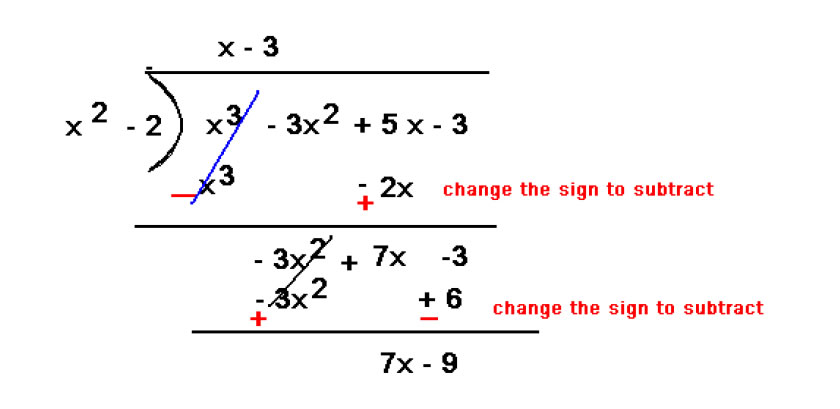
So quotient = x-3 and remainder 7x - 9
(ii)p(x) = x4 – 3x² + 4x + 5, g(x) = x² + 1 – x
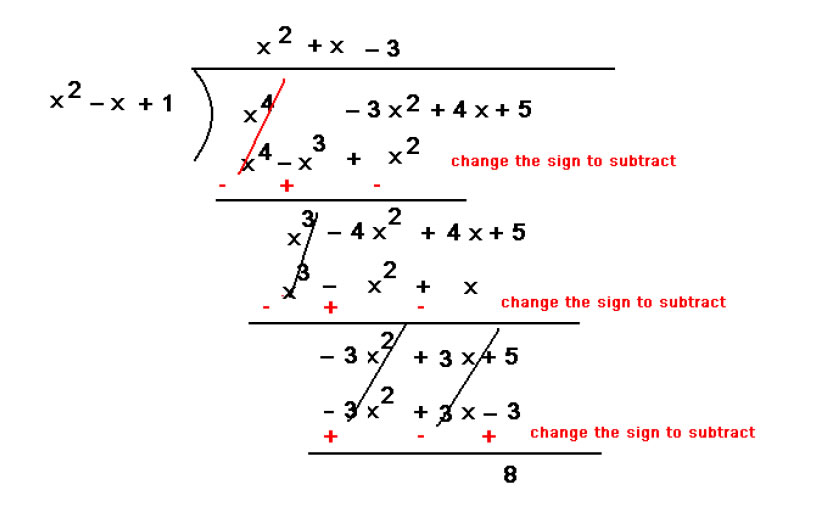
So quotient = x² + x-3 and remainder 8
(iii) p(x) = x4 – 5x + 6, g(x) = 2 – x²
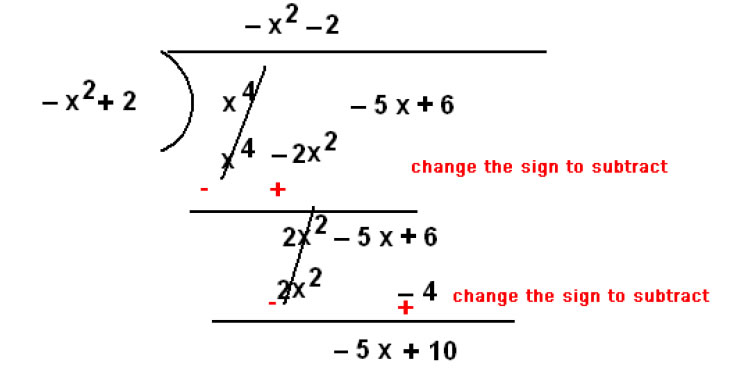
Question 2. Check whether the first polynomial is a factor of the second polynomial by iding the second polynomial by the first polynomial:
(i)t² – 3, 2t4 + 3t³ – 2t² – 9t – 12
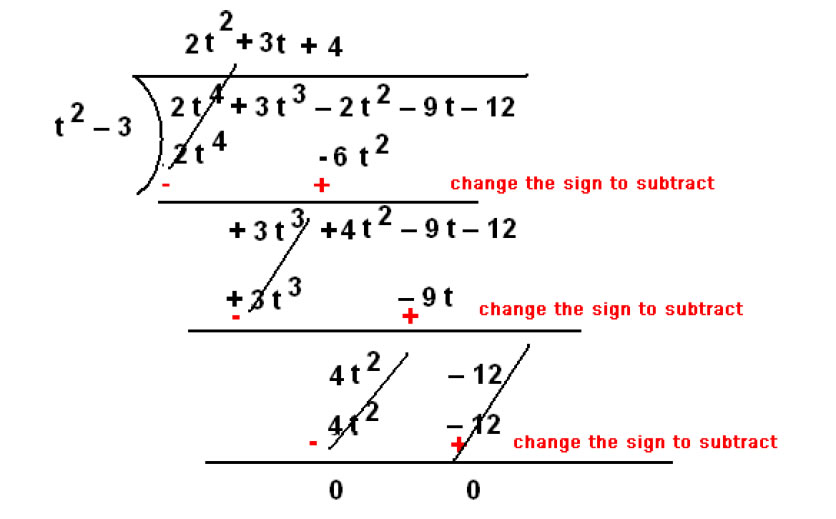
Remainder is 0 hence t² -3 is a factor of 2t4 + 3t³ – 2t² – 9t – 12
(ii)x² + 3x + 1, 3x4 + 5x³ – 7x² + 2x + 2
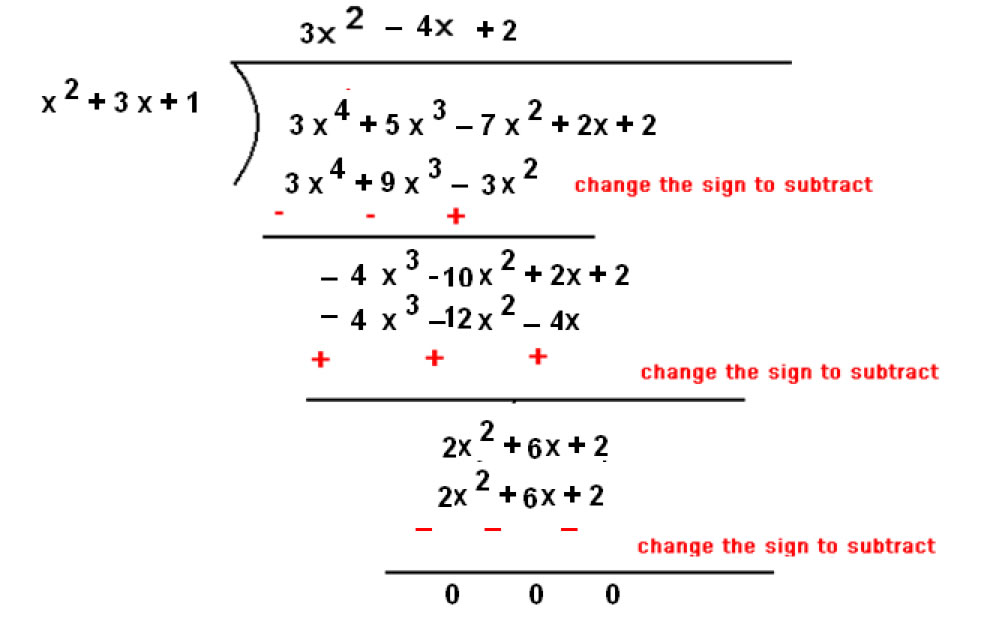
(iii)x³ – 3x + 1, x5 – 4x³ + x² + 3x + 1
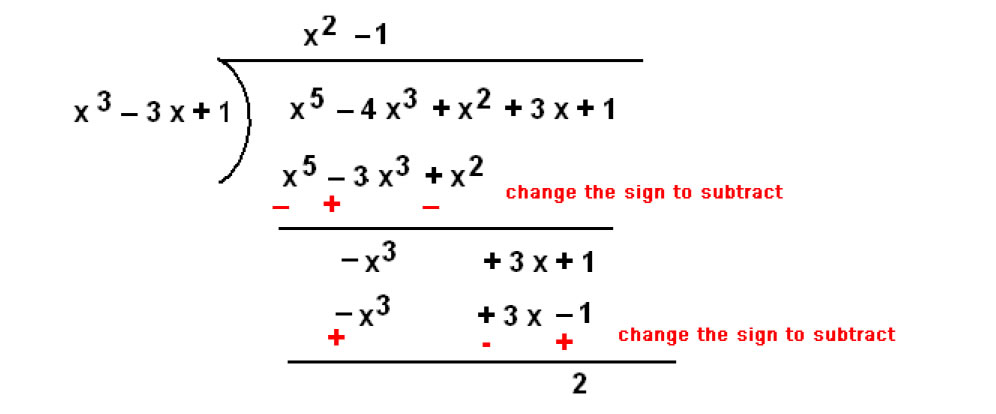
Remainder is 2 so x³ – 3x + 1 is not a factor
Question 3. Obtain all other zeroes of 3x4 + 6x3 – 2x2 – 10x – 5, if two of its zeroes are √(5/3) and - √(5/3)
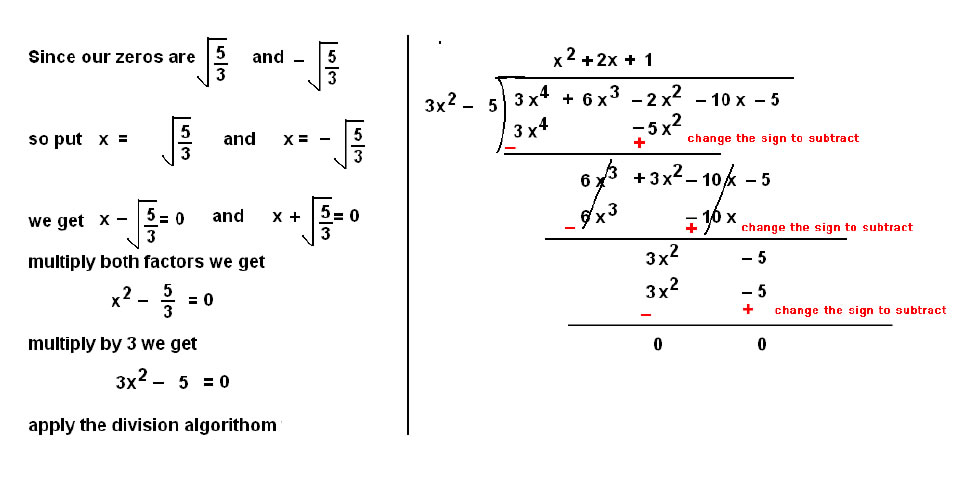
Quotient is x² + 2x + 1 = 0
Compare the equation with ax² + bx + c = 0
We get
a = 1 ,b = 2, c = 1
To factorize the value we have to find two value which
sum is equal to b = 2
product is a x c = 1 x 1 = 1
1 and 1 are such number which
sum is 1 + 1 = 2
product is 1 x 1 = 1
So we can write middle term 2x = x + x
We get
x² + x + x + 1 = 0
x (x +1) +1(x +1) = 0
( x + 1)( x + 1) = 0
x +1 = 0, x + 1= 0
x = -1 , x = - 1
so our zeroes are - 1 -1 , √(5/3) and - √(5/3)
Question 4. On iding x3 – 3x2 + x + 2 by a polynomial g(x), the quotient and remainder were x – 2 and –2x + 4, respectively. Find g(x).
According to ision algorithm
Dividen= Divisor × Quotient + Remainder
p(x) = g(x) × q(x) + r(x),
plug the value in formula we get
x³ – 3x² + x + 2 = g(x) *(x-2) - 2x + 4
Add 2x and subtract 4 both side we get
x³ – 3x² + x + 2 + 2x – 4 = g(x) *(x-2)
simplify and ide by x/2 we get
(x³ – 3x² + 3x– 2)/(x-2) = g(x)
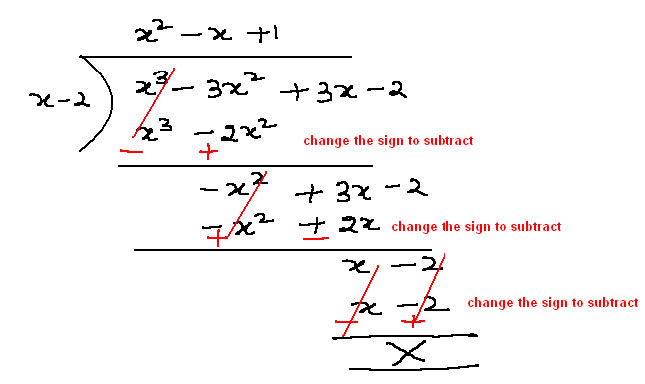
So we get g(x) = x^2 – x +1
Question5. Give examples of polynomials p(x), g(x), q(x) and r(x), which satisfy the ision algorithm
We can write many such examples
deg p(x) = deg q(x)
We can write many such examples
P(x) = x² , q(x) = x² g(x) = 1 R(x) = 0
(ii) deg q(x) = deg r(x)
Q(x) = x , R(x) = x , p(x) = x^3 + x g(x) = x²
(iii) deg r(x) = 0
Q(x) = 1 , R(x) = 1 , p(x) = x+1, g(x) = x
Copyright @ ncerthelp.com A free educational website for CBSE, ICSE and UP board.